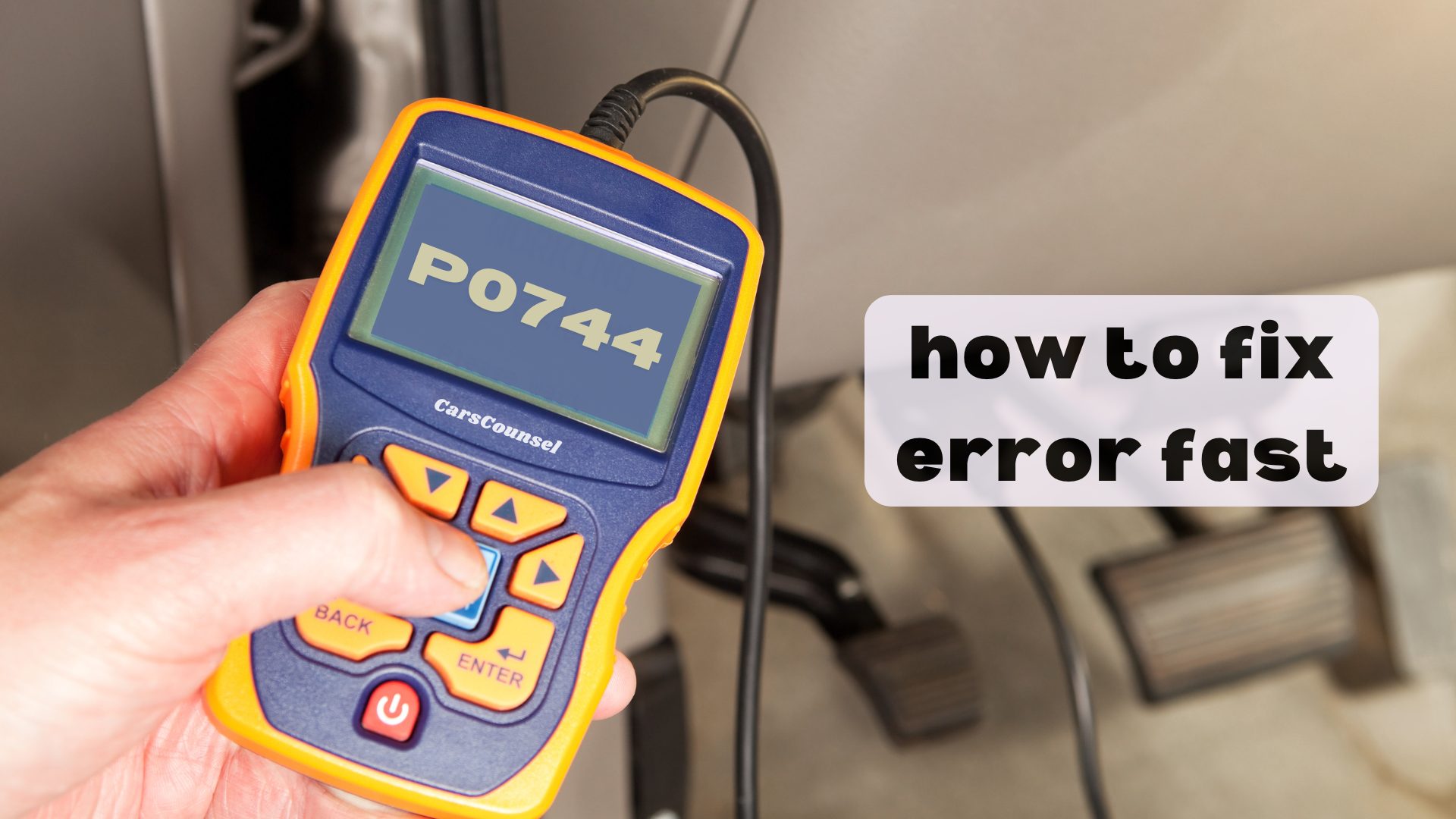Did you know that up to 10% of cars might have transmission problems within their first five years?
If you’ve come across the P0744 code, it means there’s likely an issue with the torque converter clutch.
Start by checking and maybe changing the transmission fluid—this is often the quickest fix.
But what if that doesn’t work? Next, you should look at the TCC solenoid and make sure all the wiring is in good shape.
Want to know more ways to keep your transmission running smoothly? Stick around to find out more solutions.

Quick Navigation
Key Takeaways
- Check and replace transmission fluid: Make sure the fluid is at the right level and isn’t dirty.
- Inspect TCC solenoid: Check the solenoid for any problems or wear and replace it if needed.
- Examine wiring and connectors: Look for any frayed wires or damaged connectors and fix any issues.
- Use an OBD-II scanner: Plug it into the diagnostic port to read and confirm the P0744 code.
What Is the P0744 Code?
The P0744 code is a trouble code that shows there’s a problem with the torque converter clutch (TCC) in your car’s transmission system.
This code means the car’s computer, known as the powertrain control module (PCM), can’t properly detect what’s going wrong with the TCC.
The torque converter is a part that connects the engine to the transmission, helping to transfer power smoothly.
The TCC locks the torque converter to the engine output shaft to make your car run more efficiently.
If there’s an issue, like the P0744 code, you might notice poor acceleration or your engine stalling.
Knowing what this code means can help you fix transmission problems quickly and keep your car running well.
Importance of Addressing P0744
It’s really important to fix the P0744 code as soon as you can to avoid more damage to your transmission and keep your car running smoothly. If you ignore this code, you could end up with serious transmission problems, engine stalling, and poor acceleration, which can all hurt your car’s performance. Fixing this issue quickly is crucial because if you don’t, the problems can get worse and lead to very expensive repairs later on.
Taking care of this right away helps keep your transmission in good shape and ensures your car stays reliable.
Regular maintenance, like checking fluids and making timely repairs, is essential. By dealing with the P0744 code quickly, you not only get your car back to top performance but also extend its lifespan, prevent breakdowns, and make sure it runs reliably.
Common Causes of P0744
The P0744 code can pop up for a few reasons, such as a bad TCC solenoid valve, a worn-out torque converter clutch, faulty wiring or connections, or low or dirty transmission fluid.
You should check the torque converter for any wear and tear. Also, look at the hydraulic system to make sure there’s no debris or contamination that could mess with how the torque converter clutch works.
Make sure all the wiring and connections are in good shape and not corroded or damaged.
Lastly, check that the transmission fluid level is good and that the fluid is clean.
Fixing these issues quickly can prevent more damage to your transmission and keep your car running smoothly.
TCC Solenoid Valve Issues
To figure out problems with the TCC solenoid valve, start by looking for any faults or damage that might mess up the hydraulic pressure and stop the torque converter clutch from working right.
Use a digital multimeter to test the TCC circuit for electrical continuity and proper function. If the solenoid doesn’t pass the test, you’ll need to replace it to get things working again.
Also, check the wiring and connectors for wear or corrosion, as these can also cause problems. Make sure the new solenoid fits your vehicle’s transmission system.
Follow your vehicle’s service manual for correct installation. Fixing these issues quickly will help avoid more transmission damage and boost overall performance.
Transmission Fluid Concerns
Keeping your transmission fluid at the right level and clean is crucial for your torque converter clutch (TCC) to work properly.
Dirty or low fluid can cause TCC problems and set off the P0744 code. Regularly checking and changing the transmission fluid helps you avoid expensive repairs and keeps everything running smoothly.
To keep your transmission fluid in good shape:
- Check fluid levels often: Use the dipstick to make sure the fluid is at the right level.
- Change the fluid regularly: Follow your car’s maintenance schedule for fluid changes.
Following these steps will help keep your transmission in great condition.
Identifying P0744 Symptoms
When your vehicle’s TCC (Torque Converter Clutch) circuit has issues, you might notice problems like the engine stalling or hesitation when you try to accelerate. Here’s a simple guide to help you recognize these problems:
| Symptom | Description | What to Do |
|---|---|---|
| Engine Stalling | Engine unexpectedly shuts off | Check the TCC solenoid and wiring |
| Hesitation on Acceleration | Delay or lag when you press the gas | Check the transmission fluid levels and condition |
| Transmission Slipping | Gears shift roughly | Test the torque converter |
| Decreased Fuel Efficiency | Getting fewer miles per gallon (MPG) | Make sure the torque converter is well-maintained |
Use these tips to identify P0744 issues early. Fixing them quickly can prevent more serious damage. Regular maintenance of the torque converter helps avoid these problems from coming back.
Engine and Transmission Behavior
When the P0744 code appears, your car’s engine and transmission can start acting up in ways that really hurt your driving experience.
You’ll likely see a drop in how well your engine runs and how smoothly your transmission works, making driving less predictable and potentially dangerous.
- Engine Problems: Your engine might hesitate or even stall, especially when you’re trying to speed up.
- Transmission Issues: The transmission could slip, causing the gears to not engage properly and making the car less efficient.
It’s important to fix these problems quickly to prevent more serious damage.
Regular check-ups and timely fixes can help your engine and transmission run better, making your drive safer and smoother.
Using an OBD-II Scanner
To figure out the P0744 code, first, connect an OBD-II scanner to your car’s diagnostic port to get the error codes.
It’s important to know the basics of OBD II; these scanners talk directly to your car’s computer to read trouble codes and show real-time data.
Start by finding the diagnostic port, usually under the dashboard.
Plug in the scanner and turn on the ignition without starting the engine.
Follow the scanner’s instructions to go through the menu and select ‘Read Codes.’
The scanner will show the P0744 code, confirming there’s a problem with the torque converter clutch circuit.
This first step is key to identifying the problem and helping you fix the real issue.
Inspecting Wiring and Connectors
After confirming the P0744 code with an OBD-II scanner, check the wiring and connectors for any signs of wear, corrosion, or damage that could mess up the TCC circuit.
Do a thorough inspection by visually examining the harnesses and connectors connected to the TCC solenoid. Make sure the connections are secure and the pins can move freely.
Key steps include:
- Looking it over: Check for frayed wires, broken insulation, or exposed conductors.
- Checking for rust: Look at the connectors for any rust or oxidation that might cause connectivity issues.
Fix any problems you find right away to get the TCC working properly and clear the P0744 code.
Preventing Future P0744 Issues
Preventing Future P0744 Issues
Regular maintenance and timely checks are key to stopping future P0744 problems and keeping your car’s transmission running smoothly. By sticking to a maintenance schedule, you can dodge common causes of this issue. Make sure you’re checking the transmission fluid levels and replacing it regularly to avoid contamination. Also, check the TCC solenoid and related wiring for wear or damage during regular services.
| Task | Frequency |
|---|---|
| Check Transmission Fluid | Every 30,000 miles |
| Inspect TCC Solenoid | Every 60,000 miles |
| Check Wiring and Connectors | Every 60,000 miles |
| Full Transmission Service | Every 100,000 miles |
Regular checks help you spot potential problems early, so you can fix them before they turn into expensive repairs.
More OBD-II Codes
Frequently Asked Questions
Can Ignoring the P0744 Code Lead to Permanent Transmission Damage?
Ignoring the P0744 code can lead to serious transmission damage because it causes extra wear and tear and breaks down the transmission fluid faster. Fix the problem quickly to avoid expensive repairs and keep your transmission in good shape.
How Much Does It Typically Cost to Fix a P0744 Code?
Fixing a P0744 code usually starts with a diagnostic fee of about $100. The total repair cost can be anywhere from $200 to $1,200, depending on the problem. For example, if you need to replace a faulty TCC solenoid, that will affect the final price.
Are There Any DIY Methods to Temporarily Fix the P0744 Code?
You can try quick fixes like checking the transmission fluid and adding more if needed or changing it if it’s dirty. Also, look for any obvious wiring problems and fix them if you can. These steps might help for now, but you’ll still need to see a professional to get it properly fixed.
Is It Safe to Drive My Car With the P0744 Code Active?
Driving with the P0744 code is risky. It affects how your transmission works. Use diagnostic tools to check the problem quickly to prevent more damage and expensive repairs.
Can Extreme Weather Conditions Trigger the P0744 Code?
Extreme weather can mess with your transmission and set off the P0744 code. Cold weather can make the transmission fluid thicker, and hot weather can break it down, both of which can cause problems with the TCC circuit.
Conclusion
You’ve checked the fluid, looked at the TCC solenoid, and inspected the wiring.
If the P0744 code is still there, it might mean there are deeper issues with your transmission. Ignoring it could lead to bigger problems, costing you more time and money.
Don’t let it get worse.
Think about getting a professional to check it out and make sure your vehicle runs smoothly.
Sometimes, the hidden problems are the ones that matter the most.

